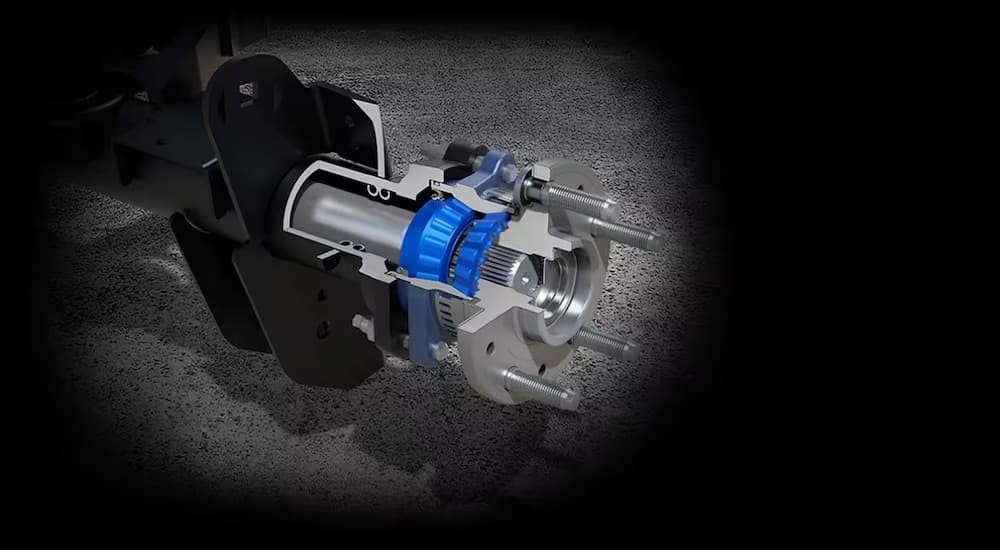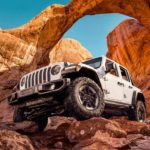The 2024 Jeep Wrangler was recently unveiled to much fanfare, and while it doesn’t look all that different from the 2023 model to anyone but the most hard-core Jeep fans, it has some pretty significant upgrades underneath the skin. While most buyers are likely entranced by the massive 12.3-inch touchscreen and the new option for power-adjustable front seats, real adventurers should pay particular attention to the addition of a full-float rear axle. If you know what that means, you’re probably already heading to the Jeep dealer to find the new model. If you don’t, no worries––you’ll soon be able to explain to all your friends exactly why the new Wrangler is so much better than the older version.
Axle Basics
To understand exactly what a full-float axle brings to the table, we need to take a step back to look at exactly what an axle is, and what it does. As any Jeep fan can tell you, the Wrangler is just about the only model on the market that still uses solid live axles front and rear. “Solid” means that there is a solid beam connecting each pair of wheels, while “live” means that power is sent to the wheels through the axle itself. This may seem pretty obvious, but the vast majority of the cars on the road don’t have live axles anymore. Instead, they use independent suspension, where each wheel is independently connected to the frame of the vehicle.
For day to day use, there are many advantages to an independent suspension system. They do a better job of soaking up bumps in the road, they take up less volume inside the vehicle, and they allow more precise engineering of how the tire moves in relation to the road. However, Jeep stubbornly sticks to solid axles because when you head off-road, things change. While a solid axle may not be as sophisticated, it is incredibly durable and allows for a tremendous amount of articulation (the measure of how much the wheels can travel in relation to the body of the vehicle). This allows Jeeps to climb over obstacles that competitors like the Bronco, which is equipped with an independent front suspension, struggle with.
![]()
Building a Better Axle
So far, so good. Nothing is changing here for the 2024 Wrangler. The difference is when we get to the “live” part of the equation. While they may look like simple big steel beams, these axles are more than meets the eye. Each axle is actually a hollow tube containing the spinning gears and shafts that transmit power from the engine to the wheels. The standard Dana axles that have equipped every Wrangler to date are a semi-floating design, which means the hub is physically connected to the driveshaft and directly supports the weight of the vehicle, transmitting that weight to the axle by a single taper roller bearing. It’s worked well enough for decades, but there is a better solution.
Enter the full-float axle. In a full-float design, the spinning components inside the axle are fully isolated (“floated”) from supporting the weight of the vehicle. Rather than having the hub physically connected to the driveshaft, a full-float axle has the hub as a separate component entirely. The driveshaft only interacts with the hub via a spline drive, and a hub is directly supported by the axle through the use of two wheel bearings inside a spindle. By taking all of the vehicle’s weight off the delicate internal parts of the axle, the full-float design is considerably more robust.
What Does That Mean in the Real World?
Okay, so on paper a full-float axle is obviously better. But the Wrangler has gotten along just fine with semi-float axles for decades, so what’s the real-world payoff? The most obvious indication of the more robust nature of the new axles is the higher tow ratings of the new model. While the 2023 Wrangler was limited to towing just 3,500 lbs, the new 2024 Wrangler can tow up to 5,000 lbs, but only in models with the new full-float axle. That, alone, is pretty convincing, but not every driver uses the Wrangler for towing. This is an off-road rig, after all, not a pickup truck (that would be the Gladiator)..
The good news is that full-float axles have an advantage off-road as well. Not only are they generally more durable than semi-float axles, which is always a good thing when you are far from civilization, but they also make it easier to upgrade to larger tires. Large tires put more stress on the axles, and many Jeep enthusiasts have added aftermarket full-float axles to support larger tires on their Wranglers. While the factory tires in the 2024 Wrangler are still relatively modest by aftermarket standards, Jeep is creeping towards larger tires, and now provides 35-inch tires standard on the Rubicon X and Rubicon 392 trims.
Another big benefit of a full-float axle, although one that you will hopefully never need to take advantage of, is that it is easier to repair on the trail. If you break a driveshaft on a semi-float axle, it is extremely difficult to get your Jeep moving again because the damaged part is also responsible for attaching the wheel to the vehicle. However, that isn’t the case with a full-float axle. Because the driveshaft doesn’t support any of the weight of the vehicle, you can quickly pull the broken part and keep on moving with power to three of your four wheels.
Which 2024 Models Have a Full-Float Axle?
The only bad news is that not every 2024 Wrangler is going to have the new full-float Dana 44 axles. If you want the upgraded part, you will have to opt for the Rubicon, Rubicon X, or Rubicon 392 trims. However, this shouldn’t be a surprise because the Rubicon trims have always come with superior suspension components compared to the lower trims. Ever since the Rubicon was first introduced in 2003, it has come standard with front and rear Dana 44 axles, while the other trims have had a Dana 30 front and Dana 35 rear (except for JK Unlimited models, which have Dana 44 rear axles).
Full-float axles serve as a good complement to the other high-end features of the Rubicon trims, from the incredible Rock-Trac 4×4 system with its ultra-low crawl ratio to the sway bar disconnect and front and rear locking differentials. The new Rubicon X goes even further with the addition of a full-time transfer case that will automatically send power to the front wheels as needed, steel bumpers with an available Warn winch, and beadlock-capable wheels. However, we have seen a trend of Rubicon features trickling down to the lower trims in recent years, so it would not be surprising to find full-float axles on the Willys and other trims in the future.
The Wrangler Keeps on Evolving
Adding technical features like full-float axles aren’t a great way to market a vehicle to the average consumer. In fact, any feature where you need infographics to show what it does is probably just going to make most peoples’ eyes glaze over. However, Jeep owners aren’t your average drivers, and Jeep understands that. The type of people who go out and buy a Wrangler do care about these things, and Jeep has responded by going out of its way to give off-roaders what they want. Now, if you find yourself the proud owner of a 2024 Jeep Wrangler, you too can explain to everyone just why it’s better than ever.





